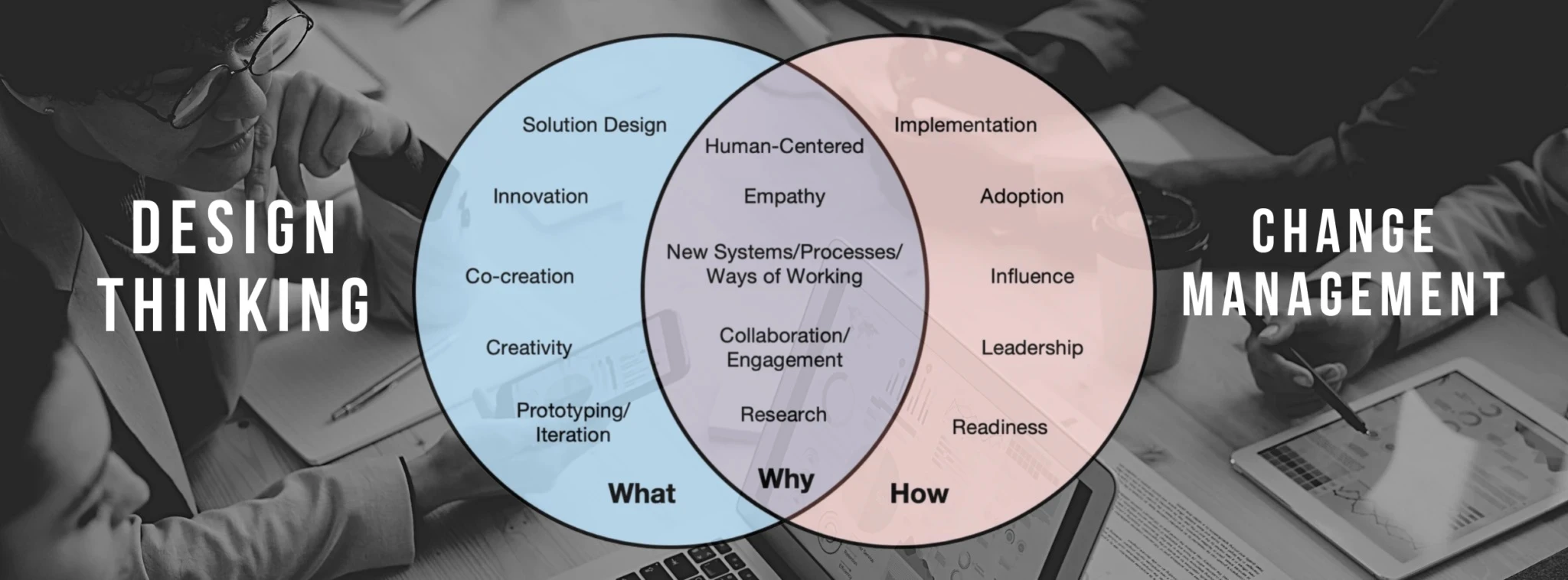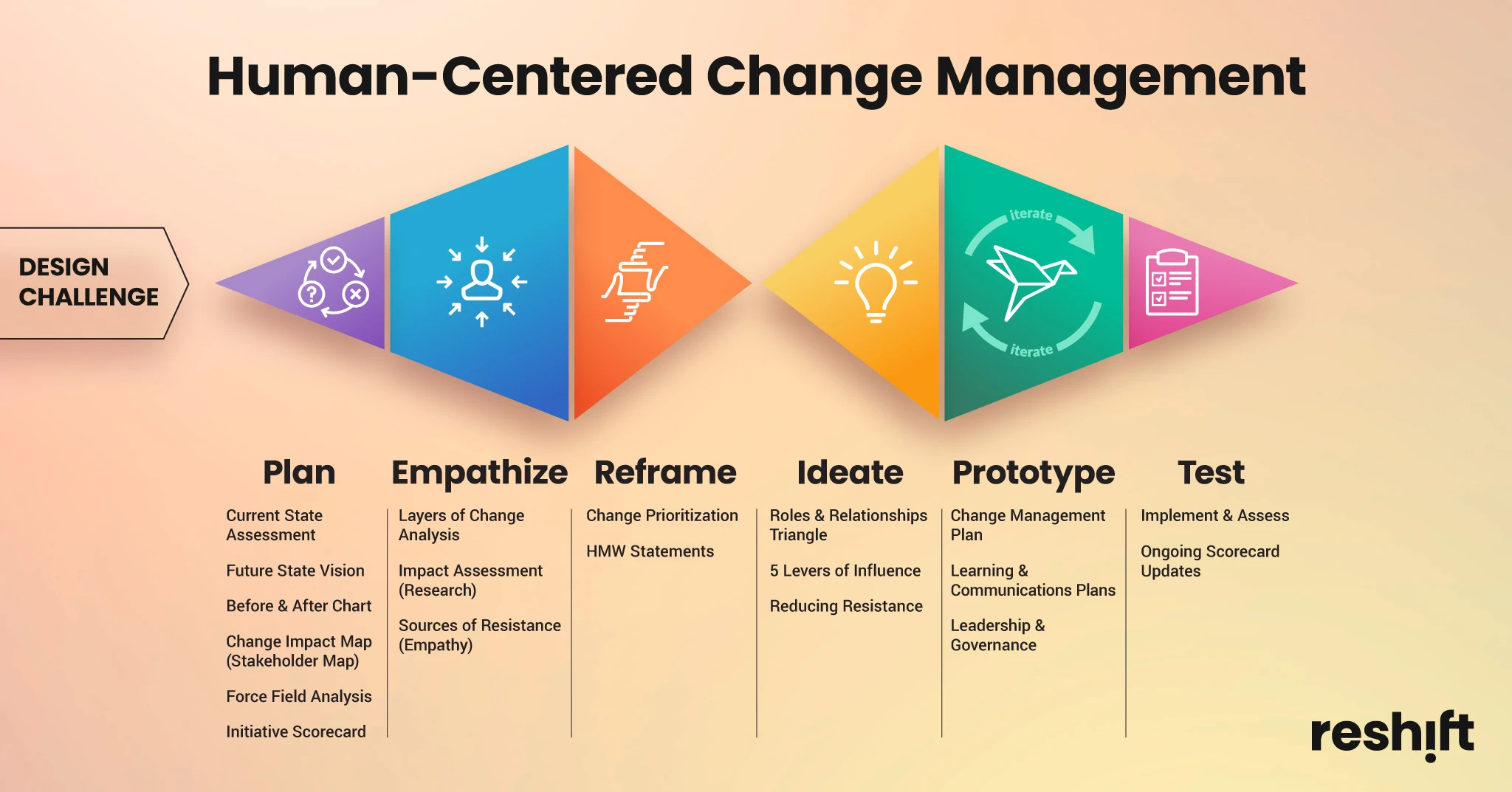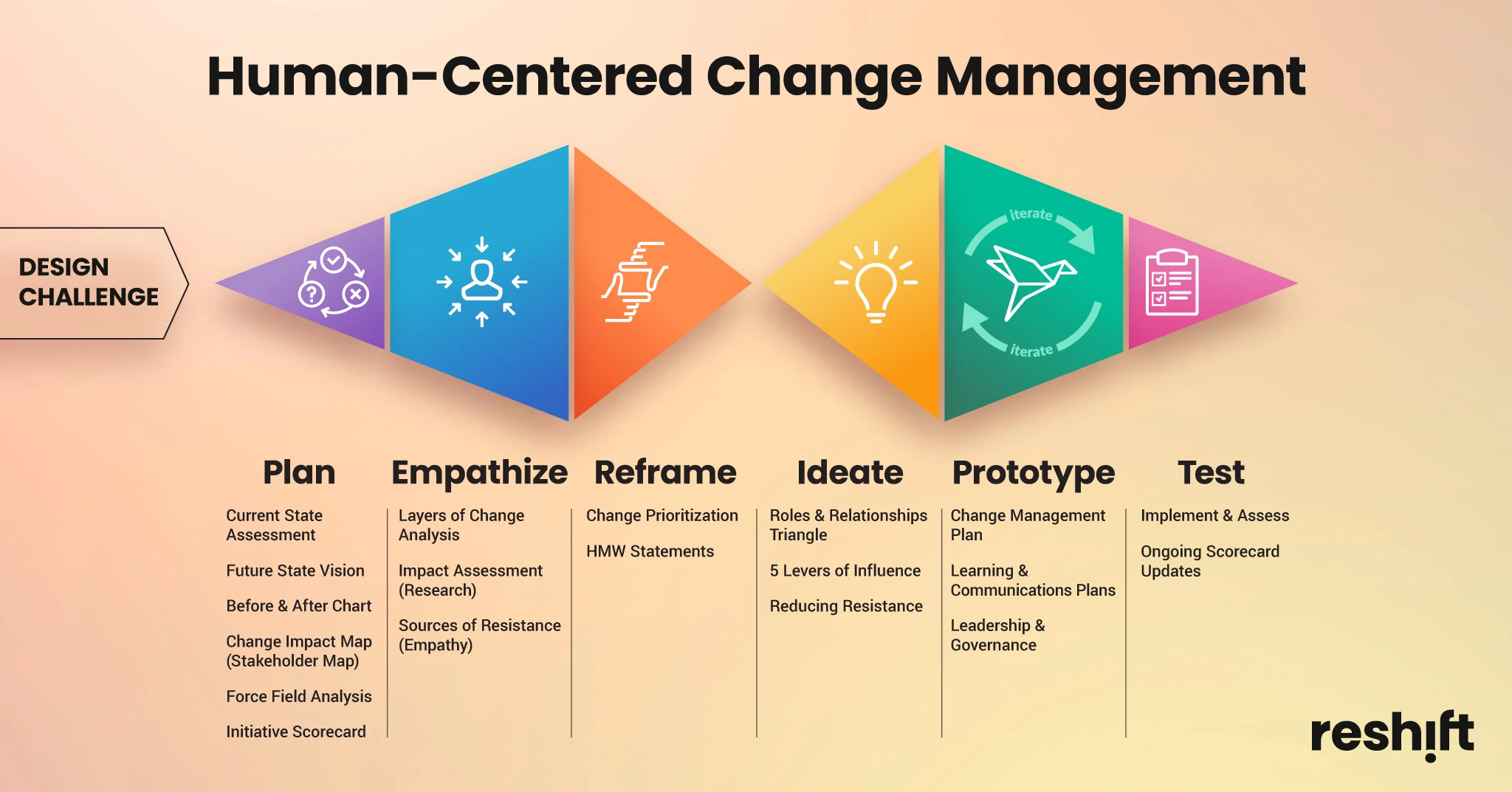Written by Heather Stagl, Steve Bosak and Marc Bolick
Businesses and organizations face constant and accelerating change. Indeed, “change fatigue” is one of the biggest challenges to making effective organizational change. To overcome change fatigue you can employ the same techniques used to design experiences to intentionally plan and implement change.
Externally, businesses are pressured by competition, shifting economic conditions, new regulations, and changing customer demands. Internally, companies have to adapt to ever-changing employee expectations, rapid evolutions in the ‘place’ where work gets done, and accelerating technology advances that are constantly pushing people, processes and systems.
“The only constant in life Is change.” This quote applies equally to organizational change and has endured for over 2,500 years after it was first written down by the ancient Greek philosopher, Heraclitus.
Managing change well is an organizational superpower
Despite the fact that everyone experiences changes in life, it is often difficult for people to endure because of their uncertainty about the post-change world. Change is especially difficult in an organizational context when employees are unsure of how the change will impact their jobs, their colleagues and even their sense of identity. Employee anxiety increases when they lack an understanding of the reasons driving the change or they lack trust in leadership.
Some leaders simply introduce change and ask people to adapt, thinking that “things will work out” and employees will adjust to the new reality. But if leaders want change to stick and succeed, they need a change management approach that is built on a deep understanding of the various impacts change has on key stakeholders.
Whether a firm is introducing new technology, improving business processes, restructuring departments, or shifting the organizational culture, a change management plan can minimize disruptions to operations, reduce resistance from employees, and ensure the organization adapts to evolving circumstances.
A well-designed change management plan includes an internal and external communication strategy to prepare employees and customers for the change. It also covers elements such as training for new systems, mechanisms to solicit feedback on the change management process, and support structures to help employees adjust to an organization’s new way of working. Perhaps most importantly, a change management plan identifies risks that will prevent successful change and ensures that intended changes align with an organization's strategy goals.
Human-centered change management
At reshift we believe that change management should be a continuous process that happens throughout the solution design and implementation process. Human-centered design prioritizes the needs and desires of the people we are serving (e.g. customers, employees, citizens, etc.) and seeks to define what needs to change to improve an experience.
Human-centered change management considers the effects on the people inside the organization who have to deliver the new experience. It is about understanding the behavioral and social dynamics that will unfold as change is implemented inside the organization, and defining how best to bring those changes about with optimal outcomes for the organization and its people.
We have written previously about the overlap of design thinking and change management. As shown in the diagram below, both share a human-centric focus on understanding why the change should happen, rooted in research, analysis and empathy for all the people involved, inside and outside the organization.

Design Thinking versus Change Management
We think of innovation as “Big Change'' that can deliver outsized benefits to the organization, its employees and its customers. Simply put, managing change throughout the design and implementation processes helps to ensure the benefits that are intended in the design process are actually realized in the implementation process.
Design elements of change management
Building on the idea that the design process and traditional change management share many common approaches and mindsets, we take the approach that human-centered change management is, itself, a form of experience design. It’s about intentionally researching, analyzing and designing the experience of the stakeholders who will experience the change.
After all, the success or failure of any change initiative depends on how these stakeholders embrace or resist the changes they experience. It’s ultimately about change experience design!
If we explore change management as an experience design process, you can immediately see how human-centered change management flows through the same design phases as any other human-centered design project. To illustrate this, we align the activities and tools used in human-centered change management with the traditional design double diamond in the figure below.

Human-Centered Change Management Follows the Double Diamond
Plan
The Plan stage of the design process frames the challenge. In the context of change, the design challenge is to move people from the current state to the desired future state. This stage then starts to define the current state, co-creates the future state, and develops goals, and then maps out the stakeholders who will be affected by the change and who have an impact on the change.
Empathize
The Empathize stage of the design process is the heart of what makes it human-centered. Just like the design process, change management includes developing and conducting research to understand how people will experience the change. Change managers compile this information into impact assessments, including understanding potential sources of resistance. Design tools such as empathy maps, personas, and journey maps can be applied to change management to provide extra understanding.
Reframe
The Reframe stage of the design process takes the insights from the empathize stage and focuses the remaining activities on the areas that will have the most impact. The reframing here is about deciding what areas to prioritize and how to frame the biggest challenges anticipated in the change project. While learning from the change impact assessments drives the attention to those who have the largest gap to cross, change management must take a more holistic view and keep all stakeholders in mind as they develop the change strategy.
Ideate
The Ideate stage of the design process is where ideas for addressing the reframed challenges are developed and selected to move forward. Similarly, change managers develop ideas for how to influence and support each of the stakeholder groups. These ideas include how to use new or existing relationships and structures in the organization to drive change, how to create the conditions for change to happen, and how to help people move past their resistance. Ideas are then selected based on their expected effectiveness.
Prototype
The Prototype stage of the design process takes the filtered ideas and develops a concept, model, or pilot to get feedback. In change management, prototypes may include draft communications messages, a pilot training program, or mock ups of incentives.
Test
In the Test stage of the design process, the prototypes are evaluated so the designers can get feedback and iterate to make improvements. Similarly, change managers can get feedback on prototypes through a change agent network, or a pilot group. As the project progresses, the change management strategies and ideas are also evaluated against the goals set forth in the Plan stage, so adjustments can be made as necessary.
Like design, change management is an iterative process. Once the prototypes are refined, you roll the solutions out beyond the test groups, continually evaluating as more people encounter them. You also repeat the whole process from Empathize to Test for all relevant stakeholders, until everyone has gone through the change successfully.
You can do this!
Human-centered change management blends the approaches of design thinking, traditional change management and organizational transformation. Effective change management isn't just about introducing new initiatives; it's about orchestrating the experience of change that guides stakeholders through the transformation journey.
By aligning with the principles of human-centered design, human-centered change management becomes a continuous process that overlays seamlessly with solution design and implementation. It's about following the design process, learning and iterating through each phase to ensure that the intended benefits of change are not just conceptualized, but tangibly realized.
Through this lens, change management transcends its traditional confines to emerge as the very essence of experience design, shaping the future of organizations in an ever-evolving world.
Is it easy? No. Can you do it? Yes, and…it takes grit and commitment, but the reward is more effective change management and a process that ensures that the voices and needs of all stakeholders are heard.
Co-author Heather Stagl is a change management facilitator who helps clients make a bigger impact by making change stick. She is the author of “99 Ways to Influence Change” and the change management toolkit “The Influence Change at Work Toolkit”. She started on this path as an industrial engineer until she got a Masters in Leadership and Change Management and realized the path to progress is people, not process.
Co-author Steve Bosak learned innovation facilitation in 1995 and applied it to his environmental policy work before learning human-centered design. Whether it’s a tech company trying to improve its customer service or an organization seeking ways to tackle climate change problems, Steve enjoys helping clients build a deeper understanding of their stakeholders and helping them develop solutions to their challenges.
Co-author Marc Bolick is founder and managing partner of reshift, an innovation support partner for leaders and teams seeking Big Change. He draws on decades of experience in product and service innovation to facilitate collaborative problem solving and drive impact for the most complex challenges organizations face.

